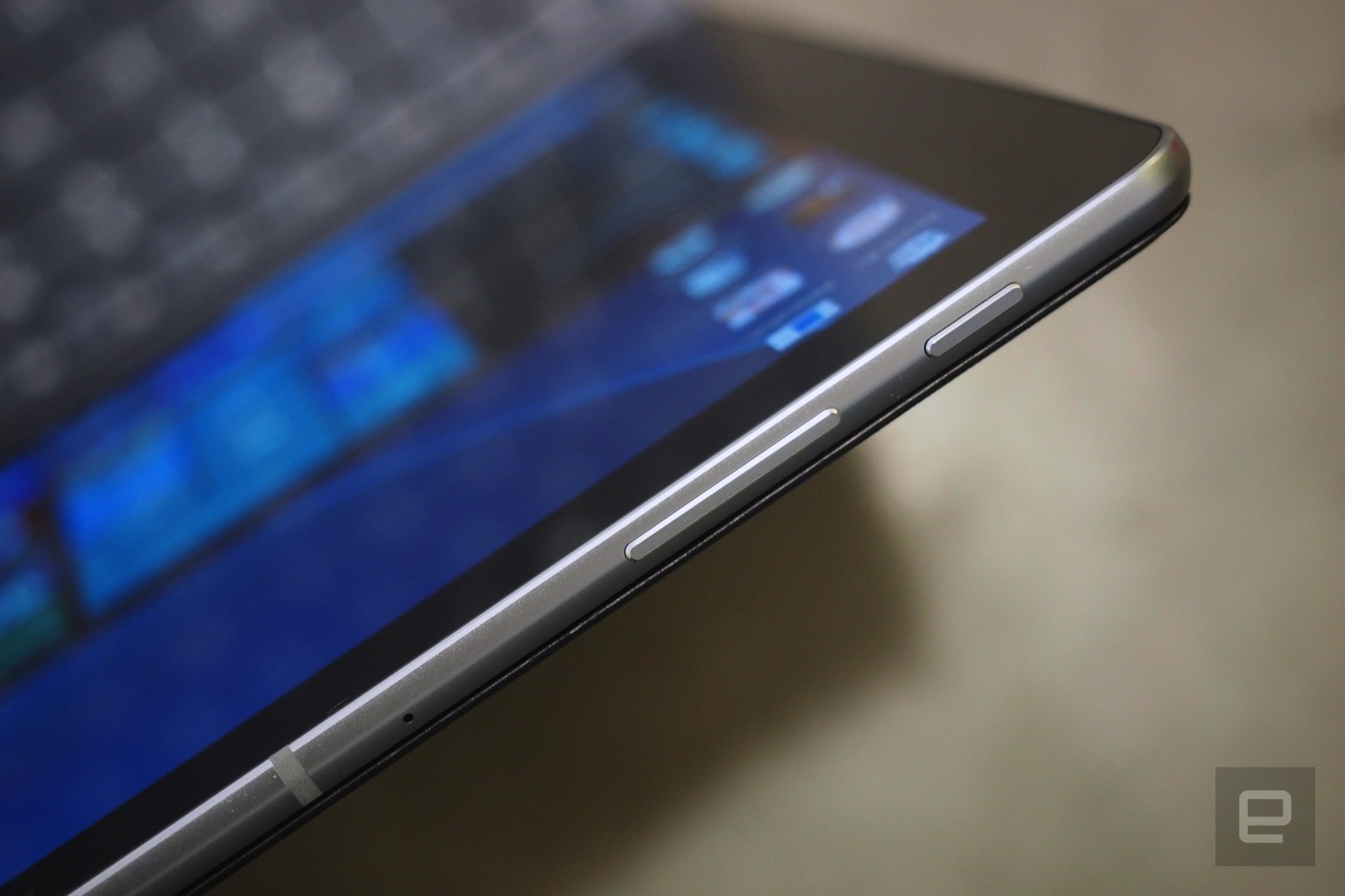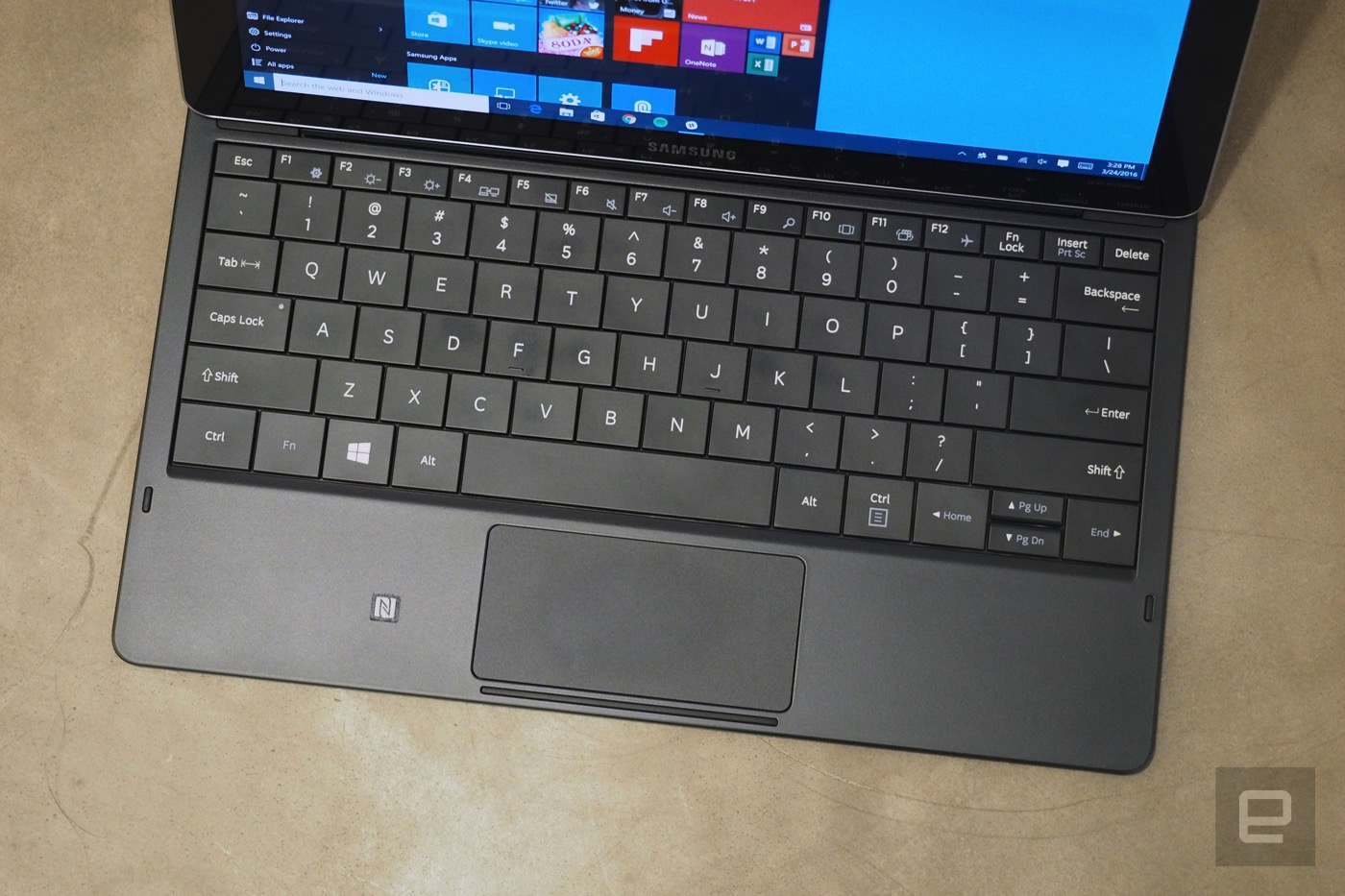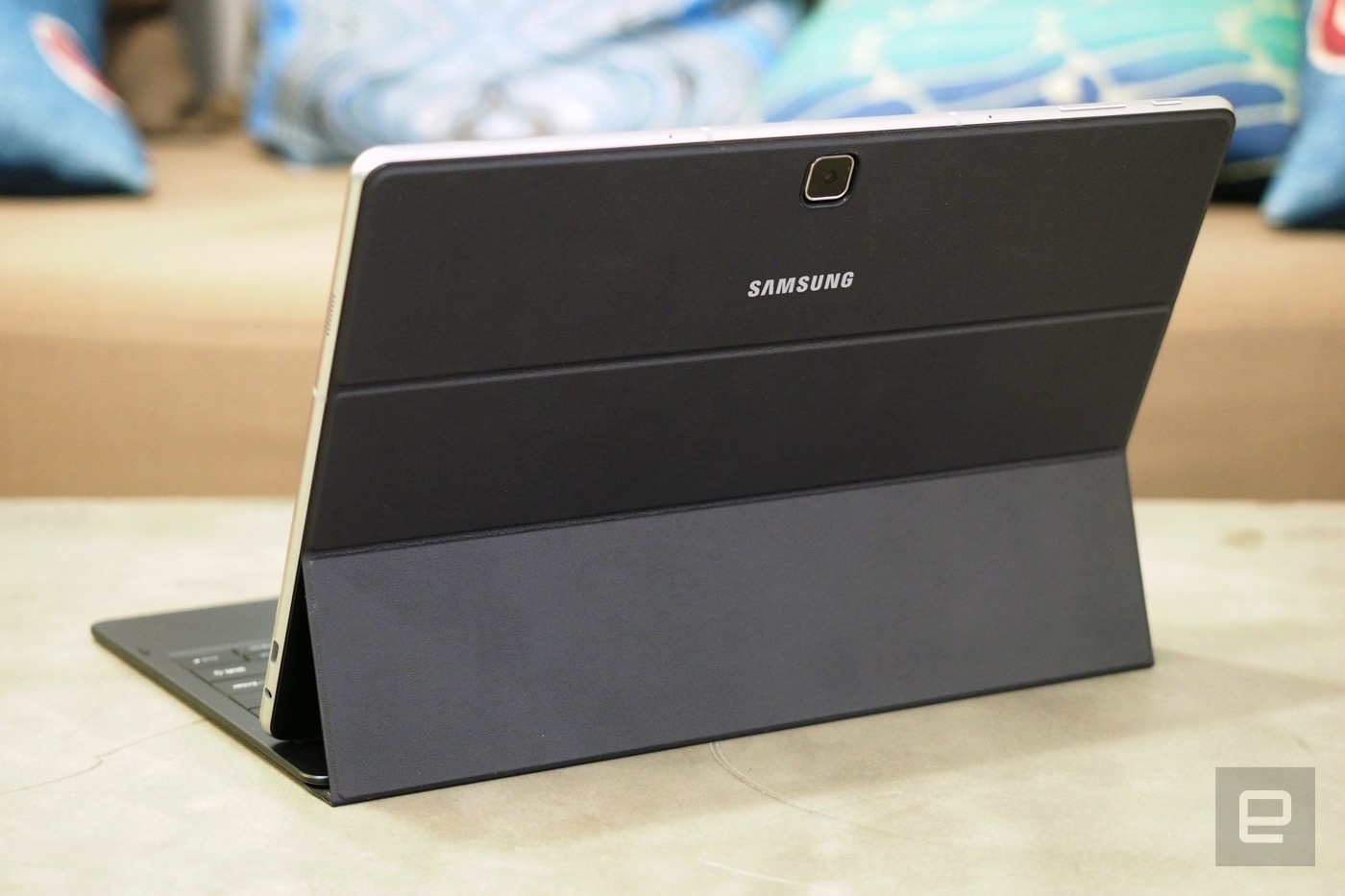Microsoft's Surface tablets are so great, it seems, that everyone wants to copy them. So far, we've seen similar devices from Apple, Lenovo, Dell, HP and Google. Incredibly, though, one of the biggest companies we cover, Samsung, is only just jumping on the bandwagon. The Galaxy TabPro S recently started shipping here in the US, and in many ways it takes after its competitors. Similar to the Surface Pro 4 and other hybrids, it has a 12-inch screen that accepts pressure-sensitive pen input, and an Intel Core M processor powerful enough to potentially replace your laptop.
Unlike some of its rivals, however, the TabPro S is the first device in its class with a Super AMOLED screen. It's also exceptionally thin and, for the starting price of $900, the click-in keyboard cover actually comes in the box (take note, Microsoft). Too bad the typing experience isn't very good.
Pros
Exceptionally thin and light
Longer battery life versus its competitors
First device in its class with a Super AMOLED screen
Touchpad on the keyboard cover works well
Cons
Included keyboard is cramped
Screen angle isn't adjustable when the tablet is docked
Performance is fine for everyday use, but occasionally sluggish
Pen not available at launch
Summary
The Galaxy TabPro S is the latest Surface Pro competitor: a tablet with a click-in keyboard that's powerful enough to potentially replace a laptop. As a first-generation product, it excels in tablet mode, offering both a thin design and long battery life -- a rare combination. But the keyboard needs work: It's cramped layout makes typos inevitable. Perhaps Samsung could retool the keyboard, but keep the same magnetic connector, making it easy for early adopters to upgrade.
Just as Samsung was getting ready to start selling the TabPro S, it invited reporters to a launch event at which execs from Intel and Microsoft were also in attendance. The message was clear: Samsung brought its hardware-design chops to the table, while working closely with the leading chipmaker and the company behind Windows 10. In theory, then, the TabPro S, was to represent the best that each tech titan had to offer.
And in many ways, the device does indeed meet those lofty expectations. For starters, this thing is unbelievably, shockingly light: 6.3mm thick and 1.53 pounds, versus 8.45mm and 1.69 pounds for the Surface Pro 4. I know, we always wax poetic in our reviews about how skinny devices are. But I seriously did not expect the device to feel this insubstantial in-hand. Combined with the keyboard cover, which only adds 4.9 millimeters of heft, the tablet feels like a book when I cradle it under one arm. Brings me back to my college days, except this time my backpack is way lighter.
Those thin edges, by the way, aren't home to many ports or openings, but they don't need to be. With the tablet docked in the keyboard, you've got the volume rocker and power button up top; a headphone and USB-C charging/data port on the right; a Start button on the left; and speakers on either side. I did find in my testing that the power button didn't always respond on my first try; there's a trick in how long you have to hold it down (longer than I initially expected, I guess). I eventually got the hang of it, but it was a little frustrating in that first week.
Hardware
Just as Samsung was getting ready to start selling the TabPro S, it invited reporters to a launch event at which execs from Intel and Microsoft were also in attendance. The message was clear: Samsung brought its hardware-design chops to the table, while working closely with the leading chipmaker and the company behind Windows 10. In theory, then, the TabPro S, was to represent the best that each tech titan had to offer.
And in many ways, the device does indeed meet those lofty expectations. For starters, this thing is unbelievably, shockingly light: 6.3mm thick and 1.53 pounds, versus 8.45mm and 1.69 pounds for the Surface Pro 4. I know, we always wax poetic in our reviews about how skinny devices are. But I seriously did not expect the device to feel this insubstantial in-hand. Combined with the keyboard cover, which only adds 4.9 millimeters of heft, the tablet feels like a book when I cradle it under one arm. Brings me back to my college days, except this time my backpack is way lighter.
Those thin edges, by the way, aren't home to many ports or openings, but they don't need to be. With the tablet docked in the keyboard, you've got the volume rocker and power button up top; a headphone and USB-C charging/data port on the right; a Start button on the left; and speakers on either side. I did find in my testing that the power button didn't always respond on my first try; there's a trick in how long you have to hold it down (longer than I initially expected, I guess). I eventually got the hang of it, but it was a little frustrating in that first week.

In the name of getting the thickness and weight down as much as possible, Samsung made some other slight compromises in build quality. Don't get me wrong, I like the look of the TabPro S's rounded corners and black matte-finish case (which ends up covered most of the time by the keyboard cover anyway). I'm just saying, if this were a beauty pageant, the aluminum-and-polycarbonate device we have here would rank as runner-up to the Surface Pro 4's magnesium enclosure and clean, sculpted lines. In some ways, then, Microsoft -- pigeonholed at Samsung's event as the software expert -- actually built the more premium device.
That said, Samsung just might have the better screen. The 12-inch, 3,840 x 2,160 panel here is, according to Sammy, the first Super AMOLED display in a device with this form factor. That might seem like a gimmicky claim -- a desperate attempt to be first at something -- but it's actually very nice. You'll notice it as soon as you boot up the device and see the "Samsung Galaxy TabPro S" splash screen: That alone does a good job showcasing the screen's deep blacks and pure whites. Samsung also helpfully pre-loaded a deep blue desktop background that showcases out of the box the kinds of colors the screen is capable of.
From there, of course, you can watch movies and view photos at full screen, but you'll even appreciate the vibrant colors on the everyday stuff, like desktop shortcuts. It reminds me of how I felt when I switched to the new 4K, color-accurate iMac as my daily driver; if you weren't using one of these machines, you wouldn't know what you were missing, but once you experience it, it's hard to go back.
Keyboard cover

I'm typing on the TabPro S's included keyboard as I write this. I don't hate it -- anymore. Similar to Microsoft's own Type Cover, the keys here are flat and arranged close together, with just the skinniest sliver of space separating the individual buttons. So although the keys provide a good amount of travel, I made many, many typos at first, and still do; it's just too easy to accidentally land on the wrong key when they're all bunched together. Also, even if I did hit the correct key, my press didn't always register, leaving me to tap, tap, tap at the Backspace button until I had gone back and retyped what I meant to say in the first place.
Now that I've spent a week with the device, and have used it to peck out many emails and Slack messages, I can appreciate that it's a more productive mobile device than, say, my smartphone. But if I had my druthers, I'd still travel with a laptop or, at the very least, a 2-in-1 with a more comfortable keyboard. Something like the HP Spectre x2, or even that Surface Pro 4 I keep talking about.
There are other problems with the keyboard. One is that the screen angle isn't adjustable, as it is on competing devices from Microsoft and HP. To its credit, at least, the keyboard cover is easy to attach: Just snap it into the magnetic connector on the bottom side, then fold the flap in the back to attach to the top of the tablet via magnets. The problem is, things get awkward when you want to switch from propped-up laptop mode to using the keyboard cover as an actual, you know, cover.
You'd think you could just unfold the propped-up piece in the back and then fold the case over the tablet, like a book cover. But to make the cover line up with the tablet, similar to a book spine, you have to also remove the tablet from its magnetic connector and scoot it down so that the case can fold over the back edge. It's a bit clumsy, and the magnets are actually quite strong. That's a good thing if ever you want to dangle the tablet upside down by its keyboard (don't), but it makes the disassembly that much more cumbersome.
On the plus side, the tablet and keyboard cover are comfortable to use in the lap, with the weight distribution such that the device never feels like it's going to topple backward. Also -- surprise, surprise -- the small touchpad built into the keyboard cover actually isn't half bad. Though it's susceptible to some of the same pitfalls as other Windows trackpads (causing me to accidentally reorder my pinned browser tabs, for instance), it's generally adept at both single-finger tracking as well as multitouch gestures like two-finger scrolling and pinch-to-zoom.
Performance and battery life
| PCMARK 7 | PCMARK 8 (CREATIVE ACCELERATED) | 3DMARK 11 | 3DMARK (SKY DIVER) | ATTO (TOP READS/WRITES) | |
|---|---|---|---|---|---|
| Samsung Galaxy TabPro S (1.51GHz Core M3-6Y30, Intel HD 515) | 4,309 | 2,986 | E1,609 / P944 / X291 | 2,119 | 550 MB/s / 184 MB/s |
| HP Spectre x360 15t(2.4GHz Core i5-6200U, Intel HD 520) | 5,040 | 3,458 | E2,672 / P1,526 / X420 | 3,542 | 561 MB/s / 284 MB/s |
| Razer Blade Stealth(2.5GHz Intel Core i7-6500U, Intel HD 520) | 5,131 | 3,445 | E2,788 / P1,599 / X426 | 3,442 | 1.5 GB/s / 307 MB/s |
| Toshiba Radius 12(2.5GHz Intel Core i7-6500U, Intel HD 520) | 5,458 | 3,684 | E2,865 / P1,622 | 3,605 | 552 MB/s / 489 MB/s |
| HP Spectre x2 (1.2GHz Core M7-6Y75, Intel HD 515) | 3,395 | 3,307 |
E1,884 / P1,148 / X331
| 2,737 | 554 MB/s / 281 MB/s |
| Microsoft Surface Pro 4 (2.4GHz Core i5-6300U, Intel HD 520) | 5,403 | 3,602 |
E2,697/ P1,556/ X422
| 3,614 | 1.6 GB/s / 529 MB/s |
| Lenovo Yoga 900(2.5GHz Core i7-6500U, Intel HD 520) | 5,368 | 3,448 |
E2,707 / P1,581
| 3,161 | 556 MB/s / 511 MB/s |
| Microsoft Surface Book(2.4GHz Core i5-6300U, Intel HD 520) | 5,412 | 3,610 |
E2,758 / P1,578 / X429
| 3,623 | 1.6 GB/s / 571 MB/s |
Like other superthin devices in this class (and at this price), the Galaxy TabPro S makes use of an Intel Core M-series processor -- a dual-core, 1.51GHz Core M3-6Y30 chip, to be exact. In addition, it's paired with 4GB of RAM, integrated Intel HD 515 graphics and a 128GB solid-state drive. As with some other Core M devices I've tested, the performance is mostly fine for mundane tasks, which in my case include juggling Slack, Spotify and nearly a dozen pinned Chrome tabs.
To maximize the fairly skimpy screen real estate, I took to working with two apps snapped side by side -- usually Chrome on the left and Slack on the right. That all worked just fine, although I consistently noticed that when I snapped Slack into place to occupy half the screen, it didn't automatically scale so that the app filled all the available vertical space; I had to manually drag the window down the rest of the way.
I also noticed that while the device ran smoothly once I got going, it could take a while after the 15-second boot-up sequence for me to fully regain control of the desktop. One time, for instance, I tried to load display settings soon after startup, but it took a few seconds to load even that simple screen. I also noticed that the back of the tablet could get warm at times, though the leathery keyboard cover helped mask that somewhat. In any case, the device never got so hot that it was uncomfortable to touch or use in my lap.
BATTERY LIFE
| |
|---|---|
| Samsung Galaxy TabPro S | 10:43 |
| Surface Book (Core i5, integrated graphics) | 13:54 / 3:20 (tablet only) |
| MacBook Air (13-inch, 2013) | 12:51 |
| HP Spectre x360 (13-inch, 2015) | 11:34 |
| Surface Book (Core i7, discrete graphics) | 11:31 / 3:02 (tablet only) |
| Apple MacBook Pro with Retina display (13-inch, 2015) | 11:23 |
| iPad Pro | 10:47 |
| HP Spectre x360 (15-inch, early 2016) | 10:17 |
| Chromebook Pixel (2015) | 10:01 |
| Lenovo Yoga 900 | 9:36 |
| Microsoft Surface 3 | 9:11 |
| Apple MacBook (2015) | 7:47 |
| Dell XPS 13 (2015) | 7:36 |
| Microsoft Surface Pro 4 | 7:15 |
| Microsoft Surface Pro 3 | 7:08 |
| HP Spectre x2 | 6:43 |
| Razer Blade Stealth | 5:48 |
| Toshiba Radius 12 | 5:12 |
So far, then, the TabPro S performs like other Core M devices, which is to say it's adequate for basic use, but, as you'd expect, not nearly as powerful as Intel's higher-end "Core i" line. What's really soured me on other Core M machines, though, is that despite having lower-powered CPUs, they didn't offer any advantage in battery life over Core i. Basically, then, the main advantage was that they were cheaper (but not even that much cheaper).
In a major exception to the rule, however, the Galaxy TabPro S not only holds its own against Core i-series systems, but outlasts them by several hours. All told, I got 10 hours and 43 minutes of continuous full HD video playback with WiFI on and the screen brightness fixed at 65 percent. That's slightly longer than the 10.5 hours that Samsung promised, and it's hours better than the Core M-based HP Spectre x2 (6:43) and the Core i5-powered Surface Pro 4 (7:15). The TabPro S might not be the most powerful productivity machine, but it more than makes up for it with enduring runtime and a thinner- and lighter-than-average design.
The competition

The Surface Pro 4. I mean, obviously. Though it starts at a similar price of $899, and starts with similar specs (Core M3, 4GB of RAM), the keyboard isn't included; it costs $130 extra. For the money, you do get a pen in the box and, of course, that slightly more premium (and slightly heavier) design. The keyboard itself is more comfortable to type on, and the Surface Pro 4's built-in kickstand allows for adjustable screen angles. Neither device is perfect; they each have some clear pros and cons. If you do want pressure-sensitive pen input, though, that makes your decision an easy one: While the SP4 comes with a writing implement in the box, Samsung's pen isn't available yet (it arrives later this quarter), and the company hasn't revealed a price or tech specs like how many levels of pressure it recognizes.
For shoppers already tied into Apple's ecosystem, the 12.9-inch iPad Pro ($799-plus) could make sense: It's powerful enough for everyday computing, supports pressure-sensitive pen input with the optional Apple Pencil ($99) and works with various keyboard covers. Battery life is on par with the TabPro S, but then again, it's bigger and heavier. Also, iOS doesn't support mouse input, which means none of the available keyboards have a built-in touchpad. For that reason, I'm hesitant to recommend it to people who expect to do a lot of typing or spreadsheet editing. That said, it's a better fit for creative types who plan to use some of the specially optimized apps, especially those meant to take advantage of the optional Pencil.
Wrapup

I don't know that the Samsung Galaxy TabPro S is necessarily better than the Surface Pro 4: It isn't offered in any comparably powerful configurations, the keyboard isn't as easy to type on, the screen angle isn't adjustable when propped up, and the pressure-sensitive pen isn't available yet. That said, the TabPro S bests the SP4 in some ways, and even succeeds in some areas the Surface doesn't. Its battery life is hours longer, despite the fact that it has a skinnier design that in theory doesn't leave room for as big a battery. It's the only 2-in-1 right now with a Super AMOLED screen, and it might just be prettier than the already-nice one on the Surface Pro 4. And, the keyboard comes in the box, which is welcome news, even if the keyboard is occasionally maddening.
The Galaxy TabPro S is a fine product in its own right -- no small feat, considering Samsung had never made a device like this before. It will be even better, too, once the company releases the optional pen. Heck, Samsung even has an opportunity to retool the keyboard; space out the buttons a bit, make the screen angle adjustable and then sell it as an optional, backward-compatible accessory. Because if Samsung can fix the typing experience -- clearly the weakest link here -- early adopters would easily be able to upgrade to a much-improved product, without having to spend $900 all over again.





No comments:
Post a Comment